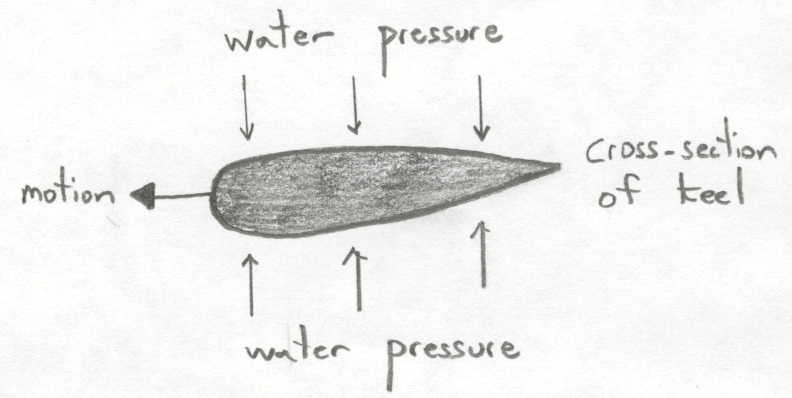Propulsion from Sails
Throughout the history of worldwide exploration, the propulsion that wind and sail can produce has proved to be a very important development. Pressure is the fundamental force involved in sail propulsion. Pressure is defined as force divided by surface area. This relationship can be manipulated to say that Force=(pressure)x(area). We can easily see from this equation that the pressure created on the area of a sail by wind will create a force. Another important characteristic of pressure is that higher pressures are perpetually striving to fill low-pressure voids. A sail is designed to create areas of differential pressure that generate lift. This lift is the force that pulls a sail boat through the water. In the picture below, the areas of higher pressure are denoted by the plus symbols and areas of lower pressure are denoted by the minus symbols. The high pressure air assumes a direct route in its attempt to fill the low pressure void and the sail is in the way. Consequently, a pressure is applied to the sail and a force results. This force is connected to the hull of the boat by the mast and away you go. 
(Picture from "The Annapolis Book of Seamanship", Rousmaniere, 1999.) The above explanation describes the situation on the left hand side of the diagram when the boat is sailing on a run (directly away from the wind). But things get a bit more interesting when a boat is sailing perpendicular to the wind (sailing on a beam reach). 

(Picture from "The Annapolis Book of Seamanship", Rousmaniere, 1999.) Good old intuition and a practical analogy will serve as a means of explaining how a boat can sail perpendicular to the wind. If you were to push on a triangle that was up against a unmovable ruler, it would shoot forward due to its shape and the pressures being exerted on both sides. This is essentially the same mechanism that propels a boat forward when wind is blowing at a 90 degree angle to its course. The ruler can be thought of as the keel of a boat resisting sideward motion due to its surface area causing drag through the water. The triangle can be compared to sail that has an angle to the boat and the wind. The picture and the diagram above can be compared to illustrate this analogy. The forward motion of the boat is further aided by a good shape of the keel. Keels are shaped to maximize the effect of this very same principle. When pressures are applied equally to both sides of the keel it has a tendency to squirt forward as illustrated below. 
But how does a sailboat sail into the wind? Thanks to an eighteenth century physicist and mathematician named Daniel Bernoulli we can explain the interesting effect that allows a boat to sail towards the wind (sail close-hauled). An extremely watered down version of Bernoulli's equation essentially says that P = 1/v or in words this says that pressure in a fluid is inversely proportional to velocity. So when a boat is sailing upwind the sail is positioned almost parrallel to the flow of wind and at an angle to the course of the boat. This allows the wind to flow along both sides of the sail. The camber of the sail allows it to act as an airfoil where the air moves with greater velocity along the leeward side of the sail (the side away from the wind) which causes reduced pressure and lift in that direction. 
(Picture from "The Annapolis Book of Seamanship", Rousmaniere, 1999.) To further increase the magnitude of this lift the jib was invented. The jib is the smaller sail seen forward of the mainsail on most sailboats. The jib funnels the wind between it and the mainsail. As the same volume of wind must pass through a smaller space in the same amount of time, the velocity of the wind must increase (the venturi effect). This increase in velocity causes a decrease in pressure and effectively produces lift in that direction. This is illustrated above.
Home / Basic Parts of a Sailboat / Principle of Bouyancy / Balance / Bibliography